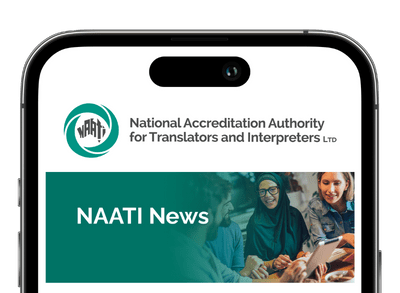Let’s be honest, YouTube is a great place for…..well…..wasting a lot of time. Yes, there are funny memes, fashion tips from the Kardashians and plenty of sporting videos.
And if you delve a little deeper, this platform is brimming with valuable and informative content.

Yes, the ‘Tube has lots of learning opportunities and plenty of educational channels, such as our own NAATI channel, which also provides links to other organisations in our sector, such as ASLIA. However, today I want to focus on why, as a T&I professional or candidate, you might want to spend some time on our channel.
Firstly, it covers a range of topics and provides helpful advice on the NAATI testing environment, information in Auslan, guidance videos for candidates, and a focus on Indigenous interpreting. For anyone wanting to get a better understanding of how the processes work and what to expect across the different testing formats, the NAATI channel is a great place to start.
Within the channel are four areas, each with a different focus, and these are explained in the following paragraphs. Of course, there is no better way to experience the content on offer than by going to the channel itself.
The NAATI testing environment
In this sub-channel you will find three videos that guide a potential candidate through the certified translator test process, detailing how the tests are run, and providing helpful tips & tricks, do’s & don’ts, as an aid to making your test experience the best it can be.
An additional two videos are aimed at the CCL (credentialed community language) test processes. The briefing video sets the scene and explains how the testing environment is managed. The second, and longer video, explains how the testing is conducted.
NAATI information in Auslan
There are four videos in this section, using both text and Auslan to explain both NAATI certification, as well as what happens on test day for both Certified Provisional and Certified Interpreter tests.
The first two videos provide information about NAATI and T&I certification, with both using Auslan as the key language. Subsequent videos explain what happens on test days, giving an insight for candidates into the process, the test requirements, and providing a relaxed format about a fictional candidate’s journey.
Indigenous Interpreters project
This series of eight videos provides potential candidates with a wealth of information to make the testing process easier to understand and reduce stress. From the initial ‘introduction’ video the series explains to the viewer terms such as meaning transfer, consecutive technique, and how to manage interactions.
The videos also provide details on speaking skills, what is meant by language proficiency, and how the tests are marked. The final video in the series explains what will happen on the day of the test. There are some great tips about what the examiners are looking for, and the whole series is a really good way to understand the process and expectations.
Videos for candidates
The last series of videos explain why NAATI Certification is so important and valuable, as well as reinforcing with candidates the ‘on the day’ testing process for NAATI Certified and Certified Provisional tests.
Finally, NAATI’s head of Certification Policy and Development, Aurelie Sheehan, has this to say about NAATI’s channel:
“All candidates should watch the appropriate videos for their test. The videos provide important information that will help candidates prepare for their test, reducing stress, and make the experience less intimidating.
We want all of our candidates to have a positive engagement with NAATI, and we wish them every success in attaining our nationally recognised qualifications.”
It’s part of our enduring vision of a connected community without language barriers.
As always, NAATI welcomes feedback on our posts and on the material, such as our YouTube channel, that we provide to the community.
